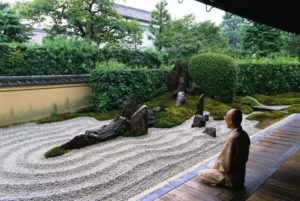#4 Zazen is Participation in Life (part 1)
- At January 10, 2021
- By drynick
- In Reflections
 0
0
Zazen is a fancy word for seated meditation. Za means seated and zen means meditation. In the Zen Buddhist tradition, zazen is our primary practice. We are encouraged to make time every day to sit in an upright and motionless posture and practice zazen. We can do this alone or in the company of others, in person or virtually**.  As students of the Zen way, we also gather for intensive periods of practice that include chanting, walking meditation, work practice, listening to talks, going to individual meetings with the teacher—but are primarily centered on ongoing periods of sitting in stillness and silence. The traditional image of a Zen practitioner – a monk in meditation robes with a shave head sitting serenely motionless in front of a carefully tended garden of raked stones – embodies this ancient practice of zazen.
As students of the Zen way, we also gather for intensive periods of practice that include chanting, walking meditation, work practice, listening to talks, going to individual meetings with the teacher—but are primarily centered on ongoing periods of sitting in stillness and silence. The traditional image of a Zen practitioner – a monk in meditation robes with a shave head sitting serenely motionless in front of a carefully tended garden of raked stones – embodies this ancient practice of zazen.
But point #4 from 31 Fundamental Teachings of Zen says: ‘Zazen is participation in life.’ What could this mean?
I understand this in two ways. First, when we are doing our zazen practice of sitting still, we are not practicing for some other time. We are not practicing music to be able to perform it at the recital. Our stillness and silence IS our life. We are not trying to achieve special states of concentration or transcendence. What we are doing as we sit is intentionally, in that moment, participating in living our true lives.
Many of us associate living with doing things. We are eager to make good use of our time. We often want to make sure we are doing what we should be doing, that we are using our lives well. Sitting still in meditation can look like it is simply a break from the busyness to pause and catch our breath before we jump back into our routine busyness. In one way, this is true. It genuinely can be a real relief to interrupt the incessant activity of our lives and DO nothing for a while. Just a short break can clear our heads and allow us to be more present in whatever we were doing.
But anyone who has sat still for more than a few moments knows that though the body may come into relative stillness, the mind is much more unruly. After a few breaths in stillness, the mind is often off to the races. Like a little puppy, it dashes here and there—thinking about what just happened, what is happening and what will happen. It doesn’t like to stay still. Though we may be in a meditation pose and even in a meditation hall, we quickly discover that the whole world has come with us.
Our zazen quickly becomes learning how to meet ourselves and work with ourselves in all our many different mind-states. Rather than trying to cut everything off (which is impossible except for brief moments) we practice the skill of appreciating what is arising without getting carried away with it. We don’t resist and we don’t follow. We learn how to participate in the life that comes to us. Rather than trying to escape or control, we pay attention and practice allowing what is already here to be here.
We really don’t have a choice, but as we slowly release our certainty that things should be different, we can participate in the fullness of our life as it actually is.
It’s not that we have to like everything, but we can slowly learn to give up our ancient struggle and allow ourselves to join in the life that is already here.
Personal Practice: Find a quiet room (in a pinch, a bathroom will do just fine) and set the timer on your phone for two minutes. Settle into an upright and dignified seated posture. Start your timer. Notice your breath. Notice the sensations in your body. Notice the feelings and thoughts that are present. Let everything be as it is—even your wondering if you are doing this right. When your timer sounds, take a deep breath, smile in appreciation and go about the rest of your day.
(Tomorrow: A second take on Zazen is participation in life.)


Follow David!